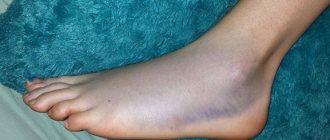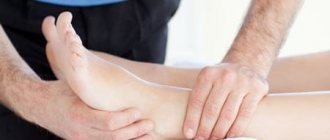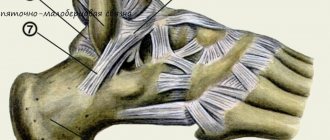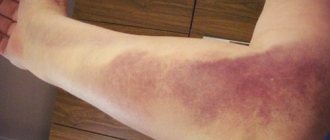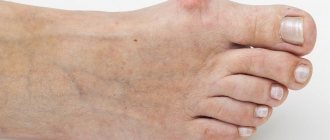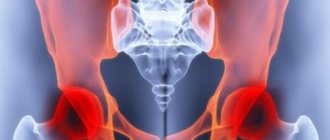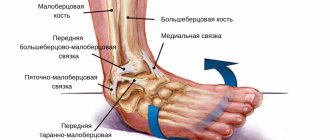In their life, almost every person has had to deal with various injuries to the ankle joints that arise literally “out of the blue.” This happens: you walk calmly along the road, not looking at your feet, and suddenly, on some hill or hole, your foot turns sharply to the side, and a sharp sharp pain appears that accompanies every movement. In such cases, they say that the person “twisted his ankle.” Why is this condition dangerous and how to treat it? Let's try to sort this issue out.
What does it mean to "twist your ankle"?
In medicine, there is no concept of “twisting your ankle.” This definition characterizes the rotation of the foot in an unnatural position for it. Most often this happens when touching the surface on which a person is moving, as well as during playing certain team sports, when contacting a ball or other objects.
The danger comes not from the unfortunate position in which the leg finds itself when walking, but from damage to the ankle joint and surrounding tissues. Most often, ligaments are affected, in some cases bones, nerve fibers and muscles. The severity of the injury and the accompanying consequences depend on what and how much is damaged.
The ankle joint, which connects the bones of the foot and lower leg, is one of the most vulnerable places in the human body. This is due to its main function: ensuring foot mobility for normal walking. Therefore, the bones that form it are small in size, together making up a complex system on which the weight of the entire body presses. The pressure increases with fast movement, such as running or walking quickly. The shock absorber in this fragile system is the ligaments that experience the maximum tension and most often suffer when the leg is twisted.
It is generally accepted that acute heel pain is caused by the appearance of a bone spur (“spur”) due to salt deposits. However, science says that this is only true sometimes (when nerve endings are compressed). Read more in the article: “how to treat heel spurs quickly and effectively.”
Consequences
Pain and swelling in the ankle indicate the presence of damage. What can be the consequences of injury?
- Sprain. Often appears due to the fact that the heel has turned inward. With such an injury, a person can walk, but with a feeling of pain. It must be treated correctly. Then the damage goes away without a trace after 2 weeks.
- Ligament tear. It is an incomplete rupture of several or one ligament at once. The joint becomes unstable, and the person who sprained his leg experiences severe pain. Recovery can occur only after a month if all treatment recommendations are followed.
- Complete ligament rupture. With such an injury, it is almost impossible to stand on your leg; acute pain immediately appears. In this case, a plaster cast is required. If necessary, the doctor prescribes surgery. The recovery period can reach two months; read more in the publication: “What to do if the ankle ligaments rupture.”
- An ankle sprain is a violation of the joint capsule. Such an injury will have to be treated for at least 10 weeks. Premature removal of the cast can provoke the development of a disease such as habitual dislocation of the ankle joint.
- Subluxation of the ankle. Assumes slight displacement of bones due to injury. The degree of damage can be diagnosed only by x-ray.
- Bone fracture. Occurs when falling or jumping from a height. When landing, the foot is twisted and an impact occurs at the same time. The rehabilitation period after a fracture is about 6 weeks. In severe cases, it takes several months to treat the injury.
Common ankle injuries
Advertising:
By stepping awkwardly on your foot and putting your body weight on it, you risk the following ligament injuries:
- Stretching
. This means that your ligaments were able to withstand the load, but at the same time small tears have formed in their tissue, due to which you will experience discomfort for a while and the damaged area will hurt when you move. - Rip or tear
. The bones retain their integrity, but the ligamentous tissues are severely damaged. This type of injury is usually accompanied by a clicking sound. The pain is more intense and pronounced. - Fracture or dislocation
. In this case, displacement of the ankle occurs, in some cases accompanied by fractures of the bones of the foot. A distinctive feature of this injury is a crunching sound and very severe pain that does not allow you to step on the injured leg.
A sprain is one of the most common ankle injuries. Accompanied by pain and swelling in its area, difficulty in working the foot. Sometimes there may be bruising, swelling, and redness on the skin at the site of the impact.
Advertising:
Sprains are divided into two types:
- with the foot turned inward (inversion);
- with the foot turned outward (inversions).
Women and girls who wear high-heeled shoes and people with high body weight often face the problem of sprains.
A sprain is a more serious type of ankle injury, which is accompanied by displacement of the articular surfaces.
Depending on which direction the displacement occurs: internal or external, dislocations are divided into several types:
- anterior (when struck from behind on the lower part of the shin, when the sole is in a fixed state, or when the foot is sharply arched downwards);
- rear (when hit from the front on the lower part of the shin with a fixed sole);
- external (with the foot turned outward, to the left or right side);
- internal (with the foot turned inward);
- upper (extremely rare, occur when falling from a height).
Also, if the ankle is damaged, conditions are possible in which the displacement does not occur completely - subluxations.
Disruption of digestive processes may be accompanied by improper distribution of enzymes, juices and liquids. The reflux of bile into the stomach is a fairly common manifestation of gallbladder dysfunction. Read more in the article: “return of bile into the stomach.”
Possible consequences
What a person calls a “twisted leg” is called an ankle joint injury by doctors. There are several types of damage that can result in a twisted leg, depending on which parts of the joint are damaged.
- Sprain - this injury occurs when collagen fibers are damaged and most often when the foot turns inward. With such damage, the victim can even walk, but his leg hurts all the time. Since the tendon cells are quite actively restored, after 7 days the ligament is almost completely regenerated, and after two weeks there is no trace of pain left.
- Ligament tear - such damage is characterized by a violation of the integrity of one or more ligaments as a result of twisting the leg. At the same time, the limb continues to function, since the ligaments can partially perform their actions. The person complains that he is in a lot of pain and does not feel stability in the joint. If treatment is organized correctly, recovery is possible in approximately three weeks.
- Ligament rupture – accompanied by complete destruction of the ligament or its separation from the bone. When receiving such an injury, the patient hears that he twisted his leg with a crunch - this is the first sign of serious damage to the ankle. After the incident, the patient cannot stand on his foot, so in this case it is necessary to transport the victim to the hospital. Here, conservative treatment will be prescribed, the leg will be placed in a plaster cast, but in especially severe cases, surgery may be performed.
- Subluxation of the joint is a displacement of the talus relative to the ankle after the ligaments are torn and no longer hold it in place. This is a combined injury, which often occurs together with ligament separation when the leg is twisted. The doctor determines the angle of displacement and the severity of the damage based on the results of the x-ray, after which the optimal treatment is selected in each specific case.
- Ankle dislocation is damage to the joint capsule when the leg is twisted and, as a result, a sharp displacement of the joint. The ankle and talus can form an angle of about 30–40 degrees with each other. A dislocated joint is treated for about two to three months by applying a plaster cast. At the same time, doctors always prefer to play it safe and slightly prolong the period of wearing the plaster, since the damage threatens to recur if it is removed early.
- A bone fracture is the most severe injury that occurs when the ankle twists. Usually accompanied by ligament rupture and joint subluxation.
Most often, a fracture occurs when a leg is twisted as a result of a fall from a height, while running or jumping. But an injury can also be caused by a blow to the foot, for example, in traffic accidents or during work activities. Restoring health after such damage takes about three months, and in some cases, four or more.
What to do if you twist your ankle
Advertising:
If, after twisting your foot, the discomfort goes away on its own within 20-30 seconds, and you feel that you can continue moving as usual, you should not take any action.
If the pain does not go away or its intensity increases, you need to pay attention to its nature.
If your sprained leg aches, you cannot step on it for an hour or more, you feel pain when you touch the ankle area, bruises or swelling appear, it makes sense to seek medical help.
An ankle sprain is a simple injury that goes away without any consequences, usually on its own. But, if, for example, a woman twists her leg or has a swollen ankle, it is important to know what to do in such cases.
- If possible, relieve the foot of the load, trying to move as little as possible so that the damaged ligaments can recover. It is recommended to stop doing household chores for a while that require being on your feet for a long time.
- A cold compress placed on the ankle joint will help relieve pain. For this purpose, you can use ice or a towel soaked in ice water. In the first 24 hours after injury, it is applied every 3 hours for 15-20 minutes. But at the same time, you cannot cool your leg too much. When the skin turns pale, remove the compress and warm the joint to normal temperature.
- To prevent swelling, put compression socks on your leg or wrap it tightly with an elastic bandage. The bandage should be snug, but not too tight on the foot to prevent blood flow from being obstructed.
- Correctly chosen position of the foot during the rest period can reduce the likelihood of swelling: it should be slightly raised up, placing a pillow under it.
To reduce pain, in the absence of contraindications, it is allowed to use ointments with an analgesic effect, as well as non-steroidal anti-inflammatory drugs: paracetamol, ibuprofen, etc.
Advertising:
What is the danger?
Many people can sprain their leg from time to time, and most patients, unfortunately, take this injury extremely lightly, often avoiding medical help. Meanwhile, in the absence of adequate, correct, and, importantly, timely treatment, a dislocation can become chronic, which significantly impairs the functionality and mobility of the damaged joint.
Possible complications include:
- Repeated injuries.
- Damage to blood vessels and nerve endings.
- The development of arthritis affecting the damaged joint.
- Necrosis of the articular head.
- The appearance of ulcerative lesions localized on the skin of the leg.
In addition, dislocations may be accompanied by damage to ligaments and bone tissue, and internal hemorrhages. Often patients consult a doctor when complications or motor activity disorders develop. Note that chronic dislocations are difficult to treat and surgical intervention may be necessary.
Therefore, in order to reduce risks to a minimum and protect yourself from such unpleasant consequences, at the first signs of injury, be sure to contact a medical facility for diagnosis and development of an optimal treatment course.
When medical attention is needed
If an injury caused by a twisted foot cannot be corrected at home, you should seek help from a specialized medical facility. This is necessary in the following cases:
- if unusual movements appear in the joint, its stability is impaired;
- in the presence of visible deformation of the bones of the foot;
- severe pain in the joint when touched for a day or more;
- inability to stand on the sore leg several days after the injury;
- if swelling or bleeding occurs in the area of injury, bumps appear or swelling of the foot;
- with numbness, loss of sensation in the foot, one or more fingers or other parts of it.
The presence of one or more of the listed symptoms should be a reason to contact a traumatologist. Sometimes, in addition to a visual examination, additional studies, such as MRI or CT, are necessary to make a correct diagnosis and select appropriate treatment.
It is not advisable to self-medicate in such cases, since in case of fractures or dislocations that can occur when the foot is twisted, failure to consult a doctor in a timely manner can lead to loss of stability of the ankle and the appearance of chronic pain that does not go away over time.
Therapeutic measures
It is very important that the ankle injury is treated completely, otherwise the patient may twist the ankle again if the ligaments or bones have not fully recovered. Treatment is carried out in a hospital, after which the patient is observed for several more days and sent home for treatment. In the first two weeks, a plaster splint is most often applied, which is subsequently replaced with a splint. Patients are administered anti-inflammatory drugs, calcium, and chondroprotectors. With their help, healing of a sprained leg occurs many times faster. It is very important that the patient is provided with complete rest during treatment.
What is not recommended to do
To minimize unpleasant consequences and avoid possible complications when treating at home, you should not:
- Take hot baths in the first days after injury
. This should not be done, as hot water will accelerate blood flow to the damaged area, which will lead to increased swelling and inflammation. - Play sports and move actively, despite the pain
. This can damage the sore joint even more. - Massage the area near the injury
. This will also cause increased blood circulation, and with it, increased swelling. In some cases, bruising may occur. - Do not remain at rest for too long
. You should avoid sudden movements for a day or two. During this period, physical activity should be minimal. But, on the third day after receiving a bruise or sprain, you can gradually stand on the injured leg. This will promote speedy healing of the injury. Exception: conditions that preclude movement due to severe pain (fractures, dislocations). To treat them you need to see a doctor.
Advertising:
If you follow these basic rules of behavior, all negative consequences from injury will be minimal. Also, for preventive purposes, after complete recovery, it is recommended to use suitable shoes with orthopedic insoles.
Bystrumgel: what it helps with and features of use
For injuries, you should not rely only on folk remedies and compresses; it is important to use local therapy, which is prescribed in 90% of cases. We are talking about special painkillers and anti-inflammatory drugs. These are medicines for external use that have a complex effect. Bystrumgel is one of them; it is a gel that is applied to the damaged area twice a day. It has the following features:
- It works quickly. The analgesic effect occurs 15–30 minutes after application.1
- Complex action. Reduces pain and inflammation, so it is used even for chronic joint diseases.2
- Gel form. Thanks to this, it has a slight cooling effect.3
- Pleasant aroma - due to the presence of lavender and orange flowers in the oil.11
The duration of the course is determined by the attending physician, but usually does not exceed 14 days11. The drug almost does not accumulate in the body, with minimal risks of overdose, so it can be used from 6 years of age3.
First aid
The body's first reaction to a twisted foot is acute pain that occurs in the area of the ankle injury, which may be accompanied by swelling of the foot and (or) ankle, hematomas, due to which the size of the foot increases several times.
If the foot has acquired an unnatural position, having shifted to the left or right side, or a lump or bruise has appeared on the bone of the ankle joint, you cannot straighten the inverted joint yourself.
At the same time, his speedy recovery and return to normal life will depend on how quickly the injured person receives first aid.
To prevent possible negative consequences after injury, the following actions must be taken:
- the leg must be secured using available means: bandage, gauze, handkerchief or neckerchief or scarf;
- the most affordable means of cooling an injured joint is a bottle of cold water (if you fell on the street) or ice from the refrigerator (if you were injured at home);
- If there are abrasions, wounds, or damaged fingers on the leg, they need to be treated with an antiseptic.
To relieve pain in the absence of other symptoms, the foot can be smeared with pain-relieving ointments:
| Name of the drug | Active substance | Effect of use |
| Finalgel | Piroxicam | Relieves pain, relieves inflammation, relieves fever |
| Fastum gel | Ketoprofen | Relieves inflammation, reduces pain |
| Nimid | Nimesulid | Reduces inflammation, eliminates pain |
| Diclofenac | Diclofenac-sodium | Relieves pain, reduces inflammation |
The listed funds are taken according to the instructions. In complex cases, the form of treatment and medications are selected by the attending physician, depending on the nature and extent of the injury.
After examination by a doctor
These remedies are only first aid. You need to see a doctor. Only a traumatologist will be able to determine the nature of the injury and prescribe the correct treatment. After twisting your leg, you need to see a traumatologist as quickly as possible. As soon as the doctor conducts an examination, takes an x-ray and makes a diagnosis, you must follow his recommendations. Usually this:
- taking medications;
- physiotherapeutic procedures.
In difficult cases, it is necessary to treat the leg in a hospital setting under the close supervision of doctors.
Read on our website
No fracture? Then the doctor will recommend treatment at home. Then you can do the following procedures:
- if the limb is swollen and painful, you need to do foot baths with the addition of sea salt several times a day (you can buy it at any pharmacy). The water temperature should not be higher than 36 degrees. The course of procedures should last about 10 days. The injured leg must be kept in the water for 10 minutes.
- Traditional recipes are effective. So, you can make compresses from burdock, cabbage leaves or aloe juice. Such remedies will help reduce swelling.
- It's important to leave your foot alone. If you twist a limb, then during the entire period of rehabilitation it is necessary to remove the load from it.
By following these simple rules, you can recover faster from injury.
Preventing ankle injuries
The tricky thing about ankle injuries is that once you twist your ankle, you become more vulnerable to subsequent injuries as a result of awkward movements, wearing the wrong shoes, fast walking, or playing sports.
Advertising:
Therefore, if you often twist your leg when walking, after which you limp for a long time or fall “out of the blue,” you should think about how to prevent the occurrence of such conditions. To do this, you need to take the following measures:
- Select and wear high-quality shoes that fit you in size and are comfortable to walk on. Preferably with a small, stable heel, with an orthopedic insole. Women need to understand that wearing high-heeled shoes makes their feet more vulnerable to injury, so they should not be worn for a long time.
- Strengthen the muscles of the ankle joint using special sets of exercises.
- Before playing sports, it is necessary to warm up, warming up the muscles well before loading them.
- Do exercises to develop coordination and balance.
To prevent sprains and more serious problems with the ankle joint, you need to be careful, because most cases of injury to this part of the body occur due to the fact that people simply do not look at their feet while moving.
After recovery
After recovery, you need to take care of your leg. She will require careful handling. After all, if you twist your leg once, the ligaments will remain stretched or slightly torn. And this will make the injured limb susceptible to further injuries. In addition, there will be a fear of twisting your leg again. After all, there is no desire for it to swell again and start hurting.
To prevent this from happening, it is recommended:
- Avoid wearing high heels. And flat soles can also harm your feet. Therefore, it is recommended to wear shoes, shoes, boots with small and stable heels;
- The ankle and ligaments must be carefully strengthened. They do this through exercise. Just 15 minutes a day will be enough. You can alternately walk around the house in different ways: on the inside, and then on the outside of the foot, on the heels, then on the toes. Walking on sand, grass or pebbles will be helpful. Of course, they need to be done barefoot.
- Massage is an affordable way to heal your feet. You can perform self-massage in the area where the injury was. It is useful to do the procedure at night. Massage is recommended not only for those who constantly twist their limbs, but also for everyone over 40 years old. After all, over the years, bones, muscles and ligaments weaken, lose their strength and elasticity.
Have you sprained your leg so badly that it is swollen and painful? You just need to see a doctor urgently. Then no complications will arise, and the treatment will be as quickly and comfortable as possible. And in the future you should just take care of your feet and constantly take care of their health.
I sprained my ankle: what ointment helps?
The first goal in treating the consequences of an injury is to relieve the patient's pain. The requirements are easily met by analgesic ointments, which are successfully used on the recommendation of a doctor and with an individual choice of an analgesic. Immediately after an injury, it is possible to use only cooling pain-relieving ointments. Analgesics with a warming effect are only allowed several days after the dislocation, when the inflammation gradually subsides. Popular ointments of this effect are:
- Viprosal;
- Ibuprofen;
- Ketonal;
- Indomethacin ointment.
A short list of ointments for sprains:
- Dolgit;
- Ketonal;
- Voltaren;
- Bystrumgel;
- Emulgel;
- Deep Relief;
- Fastum-gel;
- Nise gel;
- Diclofenac.
These products are easy to find at the pharmacy. They are based on non-steroidal anti-inflammatory drugs and are used for bruises. The medications are safe and hypoallergenic, suitable even for children of any age.
Adults should use hormonal mixtures with great caution. Such means accelerate recovery processes and help when other means are powerless, but often, along with their usefulness, can cause harm. You should trust your doctor - if the doctor has prescribed hormonal mixtures, use them strictly in the quantities specified in the prescription.
How does it manifest?
The clinical manifestations of a dislocation may differ slightly, depending on the severity of the injury and the specific location of its location. However, according to traumatologists, a dislocated leg has the following symptoms:
- Severe pain syndrome.
- Changing the shape of the damaged joint.
- Increase in local body temperature.
- Restriction or even complete absence of motor activity of the affected limb.
- Decreased sensitivity, numbness of the injured leg.
- The appearance of red or bluish spots on the skin.
In addition, the victim may have pain throughout the entire leg, not just at the site of injury. Clinical signs such as swelling, hematomas, bruises, and subcutaneous hemorrhages are also often observed.
Sometimes there may be no obvious pain syndrome. But if at the same time the victim complains that it is painful for him to step on, or experiences discomfort during physical activity, then we are talking about a dislocated leg.
How to help the victim?
First aid for a sprained leg should be aimed, first of all, at eliminating painful symptoms and alleviating the general condition of the victim. If a girl twists her ankle while wearing uncomfortable high-heeled shoes, the shoes must be removed.
If possible, the person is given a painkiller, after which they try to fix the damaged joint. For these purposes, you can use bandages, pieces of fabric, etc. If there is swelling and hematoma, it is recommended to apply an ice compress or just something cold to the damaged area of the leg. After this, it is imperative to take the victim to the emergency room!
About diagnostics
A dislocation of the lower limb often has similar symptoms to sprains, fractures and other injuries. Therefore, only a traumatologist can make an accurate diagnosis of the victim. For these purposes, the patient is prescribed an X-ray examination.
Folk remedies
If a person twists his leg and the ankle is swollen, but there is no serious injury to the ankle, you can get by with folk recipes. They are based on the use of plant decoctions, compresses and baths.
Baths with salt and aromatic oils will help relieve swelling and relax your leg. This is not only useful, but also a pleasant procedure.
It is necessary to collect warm water in a suitable container (basin). Dissolve regular salt in it in the proportion of 4 tablespoons of salt per 2 liters of water. Add a few drops of eucalyptus, pine or spruce oil, mint. Lower your legs into the basin for 15 minutes in the evening. Then dry your feet with a towel, apply gel or cream and leave the injured foot at rest.
This procedure is best done at night. Moreover, the saline solution can also be used for a compress. It will help quickly relieve swelling and reduce discomfort. So, if a person has twisted his ankle, he can be treated at home only for moderate pain that does not interfere with movement. If the pain is severe, you should go to the hospital to avoid complications.
Causes
An interesting fact is that it is quite difficult to single out any specific reason leading to twisted legs. The factor of chance plays a big role here, because you can sprain your ankle in any situation. However, we note the most common factors that provoke twisted legs:
- Sports injuries, especially in those sports where the most load falls on the ankle, it is quite easy to twist the leg (figure skating, speed skating, athletics).
- Walking in heels.
- Unsuccessful fall from a height.
- Seasonal injuries (for example, you can easily twist your leg in icy conditions).
- Excess weight.
- Physical inactivity.
- Weak ligaments in the legs.
How to avoid consequences after injury
Despite the fact that most often a twisted leg ends in a slight sprain and does not require special treatment, this condition should not be ignored, since if simple rules of behavior are not followed, a harmless injury can develop into a chronic condition.
The main condition for rapid rehabilitation: providing rest to the sprained ankle ligaments, tight but not too tight fixation of the ankle joint, applying cold to the injury site and taking painkillers if necessary.
If you have other symptoms, if your leg is very swollen and blue, you feel pain in your knee, ankle and you cannot stand on your leg, you should immediately consult a doctor to take appropriate measures. There is no point in delaying this, as the nature of the damage may be more serious than it seems.
For example, grade 1 and 2 dislocations can be quickly cured, but recovery from a grade 3 injury will take about three months. It has been noticed that women who wear uncomfortable high-heeled shoes most often encounter such problems.
In general, in this case, the best type of treatment is prevention, thanks to which you can avoid serious ankle injuries and their consequences.
Brief description and reasons
A dislocated leg can be either congenital or acquired.
In the first case, there is a pathology of intrauterine development, however, in practice this happens quite rarely (according to statistical data, no more than 10% of all dislocations of the lower extremities). Acquired dislocation is a traumatic injury with concomitant displacement of the joint. As a result, the victim experiences damage to the joint capsule and ligaments, and the motor activity of the lower limb is impaired. Traumatologists distinguish the following types of leg dislocations:
- Damage to the ankle joint.
- Dislocation of the foot.
- Hip dislocation.
- Damage to the knee joint.
- Sprained toes.
Please note that this injury can be caused by a variety of factors. You can sprain your leg, for example, while playing sports, slipping on ice, or tripping in uncomfortable shoes. Foot injury often occurs when the ankle twists. It can also be provoked by diseases of the musculoskeletal system, such as polio, arthritis, arthrosis, etc.
In any case, if you twist your leg and suspect a dislocation, you should immediately seek help from a qualified specialist to avoid the development of extremely undesirable complications!
Preventive actions
To prevent leg dislocation, patients should listen to the following recommendations:
- Wear comfortable shoes.
- Use caution when playing sports.
- Include in your diet foods rich in calcium and other substances that are beneficial for bone and cartilage tissue.
- Take strengthening vitamin-mineral complexes and calcium supplements.
A traumatologist will help determine how to treat a dislocated leg in a specific clinical case! The main task in case of injury is to competently provide first aid to the victim and deliver him to the emergency room. A timely visit to a doctor and competent treatment will avoid the development of complications and significantly speed up the rehabilitation process!
